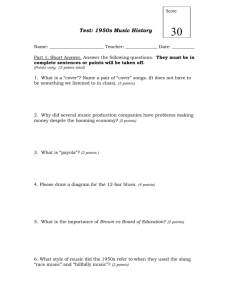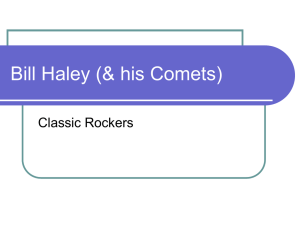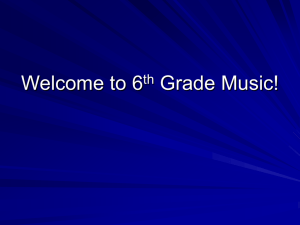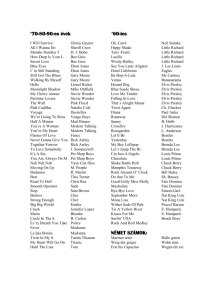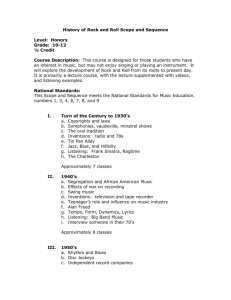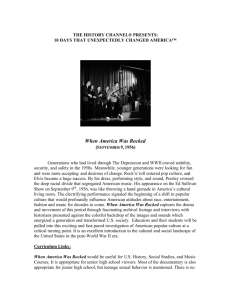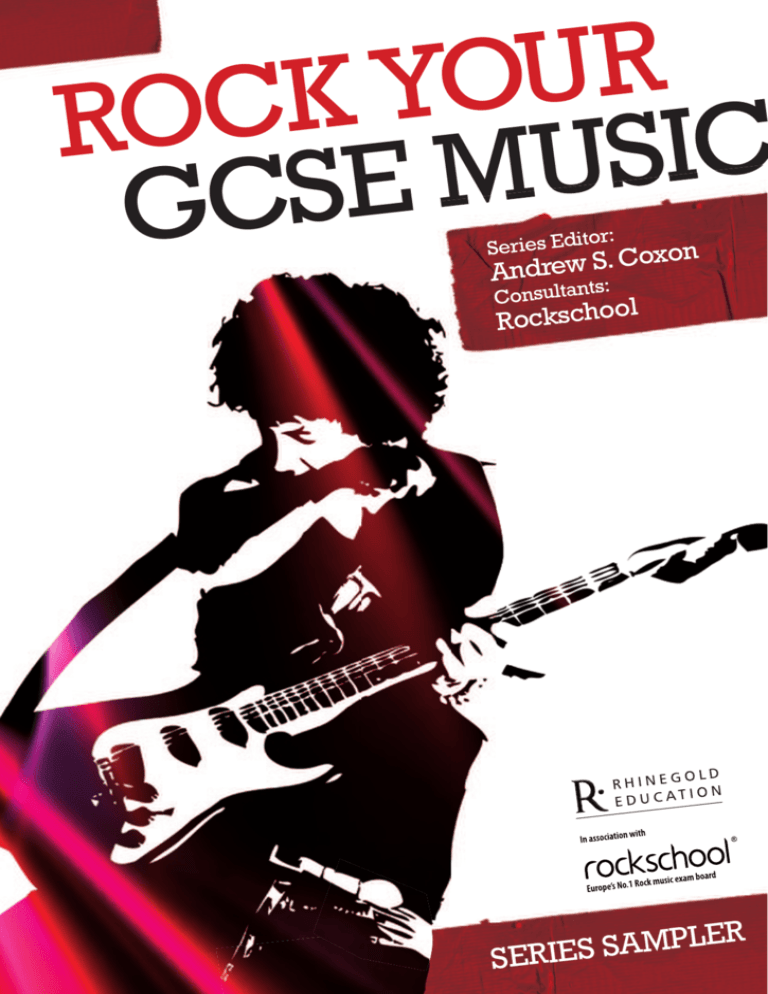
R
u
o
Y
k
c
o
R
c
I
S
u
M
E
S
c
G
itor:
Series Ed
on
x
o
c
.
S
w
Andre ts:
consultan
ol
Rockscho
R
E
L
P
M
A
S
SERIES
r
u
o
Y
k
Roc MUSIC
GCSENT’S HANDBOOK
STUDE
Contents
Introduction
Website Contents
Project 1:
Elvis Presley:
‘Jailhouse Rock’
Project 5:
Kaiser Chiefs:
‘Ruby’
Project 2:
The Beatles:
‘We Can Work It Out’
Project 6:
PAUl McCARTNEY
& WINGS:
‘Live And Let Die’
Project 3:
Coldplay:
‘Clocks’
Project 4:
Bill Withers:
‘Lean On Me’
Project 7:
Adele:
‘Rolling In The Deep’
Project 8:
Bob Marley:
‘NO WOMAN, NO CRY’
Glossary
2
SE
RIE
SS
AM
PL
ER
Project 1:
Elvis PrEslEy:
‘JailhousE rock’
‘Jailhouse Rock’ is one of the
standout songs from the film
of the same name starring
Elvis Presley. The film was
released in late 1957 and the
single topped the charts on
both sides of the Atlantic
in January 1958, going on
to sell more than three
million copies worldwide.
This is an excellent song to perform in a GCSE Performance Unit.
The guitar, bass, drum and vocal parts are generally straightforward
but there is plenty for you to get your teeth into:
Guitarists – performing in the key of eb will require familiarity with an unusual
fretboard position. In addition there is alternate picking to master
and a solo to play, and all at 168 beats per minute!
Bass players – you will face similar positional issues in the key of eb as
the guitarists, as well as getting to grips with how to play walking basslines.
Drummers – your job is to provide a solid ‘backbeat’ to the song while at
the same time demonstrating how to move between the backbeat and swing
time feels.
Singers – you will get the chance to emulate the vocal talent and delivery of
one of the acknowledged kings of rock and roll singing, elvis Presley. the part
requires accurate pitching ability and absolute confidence in delivery.
3
ER
L
MP
A
S
S
E
RI
E
S
rocK YoUr GcSe MUSIc: sTudEnT’s handBook
About Elvis Presley
By 1958, the rock and roll phenome
non in the USA
had been going for more than two
years and elvis
Presley was its biggest star. elvis Aaro
n Presley was
born on 8 january 1938 in tupelo,
Mississippi,
where he lived with his family until
moving to
Memphis, tennessee, when he was
13.
the young elvis was a natural perfo
rmer, coming
second in a Mississippi talent comp
etition at the age
of ten with a version of the well-know
n country
tear-jerker, ‘old Shep’. In August 1953
, the 18 year
old elvis entered Sun records’ recor
ding studio to cut a disc, supposedly
as a birthday present for his mother.
the recording of the Ink Spots’ tune
‘My
Happiness’ came to the attention of
the studio manager, who quickly infor
med
the studio owner, Sam Phillips.
Phillips recognised that elvis was a star
in the making and nurtured the youn
g
man’s talent for more than a year befo
re releasing any of his records. He team
ed
elvis up with two young country musi
cians, guitarist Scotty Moore and uprig
ht
bass player Bill Black. Drummer D. j.
Fontana was added to the group in
1955.
the result was startling: here was a
white singer who could, on record,
soun
d
convincingly like a black performer.
By the end of 1955, elvis had come
to the attention of circus impresario
(and
illegal immigrant) ‘colonel’ tom Parke
r, who was to become his manager.
He
remained so for the rest of elvis’s life.
Parker negotiated elvis’s move from
Sun
records to recording giant rcA, leadi
ng to a breakthrough year for elvis
in 1956.
In january of that year, he entered the
rcA studios in Nashville and made
what
is now considered to be his definitive
record: ‘Heartbreak Hotel’. It was a
start
ling
debut. the song uniquely captured
the mood of teenage loneliness and
was a
smash hit. It topped the American chart
s for two months – elvis had arrived
on
the national scene with a bang.
Between 1956 and 1958 elvis mad
e four films for MGM, starting with
the
Western Love Me Tender in 1956 and
finishing with King Creole in 1958
at which
point elvis was drafted into the Unite
d States Army. the third of these films
was
Jailhouse Rock, released in the autu
mn of 1957.
4
SE
RIE
SS
AM
PL
ER
Project 1: Elvis PrEslEy: ‘JailhousE rock’
Jailhouse Rock: The Film
Jailhouse Rock is one of a number of important rock and roll films of the
period and features one of the best music scores. The title song was written
by Jerry Leiber and Mike Stoller. The songs feature excellent choreography
throughout, especially the title song, which was performed as though it was
appearing on a television show, a common device of the time.
Elvis plays the part of Vince Everett who discovers a latent talent for
performing while in jail, and who is taught the guitar by his cell mate, Hunk
Houghton (played by Mikey Shaughnessy). On his release, Vince hooks up
with talent scout Peggy (played by Judy Tyler) and they take a number
of Vince’s songs to a record label which promptly gives them to another
performer to sing. Vince and Peggy decide to set up their own company and
they achieve great success. This, however, has an adverse effect on Vince
who comes to consider himself a cut above his former associates. There is a
confrontation between Vince, Peggy and Hunk, who punches Vince in the
neck, damaging his vocal chords. The film ends with Vince recovering and
reconciled – the end titles track is the ballad ‘Young and Beautiful’.
‘Jailhouse Rock’: The Song
‘Jailhouse Rock’ is an up-tempo number that is built around the usual rock
combo of the time (one electric guitar, bass, drums and the vocal soloist)
but also includes additional instrumentation: brass (alluded to in the lyrics,
although silent until right at the end) and piano. It is probable that Elvis’s
usual backing band plus Mike Stoller on keys played all the parts (they all
appear in the film at the end). Scotty, Bill and D. J. are the main musicians on
the original recording which was lip-synched in the film.
5
ER
L
MP
A
S
S
E
RI
E
S
rocK YoUr GcSe MUSIc: sTudEnT’s handBook
‘JAILHOUSE ROCK’ SONG FORM
the song form represented by ‘jailhouse rock’ is a version of a 12-bar blues.
As the name implies, this is where a song is played, often repeatedly, over a cycle
of the same 12 bars. Sometimes, the name 12-bar blues is used as a shorthand
for any song that uses a similar chord structure as a standard 12-bar format but
uses either more or fewer bars (for example, either eight or, more commonly, 16).
Have a look at the box for further examples of this type of song form and variants.
‘jailhouse rock’ is an example of a variant on the 12-bar format and is really a
16-bar blues, split into two sections of eight bars: eight bars of ‘verse’ followed
by eight bars of ‘chorus’. It also has a four-bar intro section at the beginning after
which elvis begins to sing.
At the core of many rock and roll songs, including ‘jailhouse rock’, is the chord
progression represented by the roman numerals ‘I, IV, V’. the numbering system
used here shows where the song starts in its ‘home’ key (known as the tonic
chord) before moving first to the IV (known as the sub-dominant) and then to
the V (also known as the dominant) before going back to the tonic (I) again. In
‘jailhouse rock’ the equivalent chords are: eb, Ab and Bb. When represented as
upper case roman numerals, it shows that the chords are major chords. If you
add a 7th voicing to the IV and the V chords (making them IV7 and V7), this
creates musical ‘tension’ and leads to what is called a turnaround, where you
resolve the chord from the V back to the tonic. the beauty of the numbering
system used to describe pop songs is that if you are familiar with their use you can
transpose a song into any key and know which chords make up the progression.
Strophic Form
‘jailhouse rock’ is also an example of what is called strophic song form. this is
where the verse and the chorus are essentially one and the same. Song forms are
usually defined by capital letters, in this case a strophic song form is represented
as: AAAAA…, depending on how many cycles are in the song. In ‘jailhouse rock’
the song is repeated five times. the first verse-chorus followed by four more versechoruses plus a guitar solo inserted between repetitions three and four. What can
be described as the verse in ‘jailhouse rock’ is essentially all sung by elvis on the ‘I’
(i.e., the tonic chord) and the chorus is sung over the I, IV and the V chords. to all
intents and purposes, the verse of the song is sung by elvis on just one note,
Look up the bold words in the glossary at the end of the book if you
don’t know what they mean! this is all musical language you need to know
for your GcSe.
6
SE
RIE
SS
AM
PL
ER
Project 1: Elvis PrEslEy: ‘JailhousE rock’
a high Gb (see Performance Notes for Vocalists later on in the chapter), with only a
few variations in the vocal line.
The key of Eb and the Eb blues scale
Mike Stoller, who wrote the music in the partnership, most likely composed the
song on the piano which explains why it is in the key of eb. As a result, the home
key of the song is potentially awkward for inexperienced guitarists and bass
players as the main chorus parts of the song can only be played in standard tuning
up the fretboard rather than in ‘first position’. It is good training to learn parts in
a band in keys other than the most obvious ones for the instrument, the musical
examples presented here all assume that the guitar and bass parts are played in
normal standard tuning.
the notes of the major scale of eb (which has three flats in it as denoted in the key
signature at the top of the score) are:
eb, F, G, Ab, Bb, c and D.
the three flats are e, A and B.
Another scale often associated with a 12-bar blues is the blues scale. this is the
same as a minor pentatonic scale but with a flattened fifth. this is an important
scale for guitarists who may use this scale when soloing over the chord changes
and for vocalists when pitching their melody lines. the notes of the eb blues scale
are shown in the example below.
7
ER
L
MP
A
S
S
E
RI
E
S
rocK YoUr GcSe MUSIc: sTudEnT handBook
TIME SIGNATURE
there are some other aspects of the song that need to be taken into account
before tackling it. the first of these is the ‘time signature’. this is shown at the
top of the score with the note q = 168 which means that the song is played
at 168 beats per minute (usually shortened to bpm). this indicates that every
quarter note, or crotchet, is to be played at this speed, this is commonly called the
tempo (after the Italian for speed). You can set this speed on a metronome (you
can acquire many versions of electronic metronomes on the internet or you can
download a metronome app if you don’t have a real one).
Project 1: Elvis PrEslEy: ‘JailhousE rock’
PRACTISING THE SONG
rhythmically
to doadvisable
so wouldto
make it more difficult to read (see the
When playing this song as a soloistrepresented
to the backing
track, it as
is often
performance
notes
for
drummers
below).
start playing over the ‘full version’ of the song as this will give you an idea of
what has to be played. If you haveSwing-time
access to a‘feel’
pieceisofone
software
allows
of the which
main characteristics
of popular song in the 20th
you to slow the speed of the songand
down
without
losing
the
pitch
then
this
will and underpins most r&B, blues,
21st centuries from the jazz Age onwards,
be a distinct advantage at first. this
willand
allow
buildpop
up song
the speed
ofPlaying
your songs using a swing-time feel
rock
rollyou
andtoother
forms.
performances gradually before attempting
the
song
at
full
tempo
and
using
the
has performance implications for most instrumentalists,
particularly for guitarists,
backing track version.
bass players and drummers. this, added to the fact that in ‘jailhouse rock’ the
guitarists
bass
players are
playing
When performing this song in a group
withand
other
musicians
playing
the their
otherparts in an unfamiliar position on
the the
fretboard,
can make
for tricky performances.
Add in the fast tempo and you
parts you can try the same tactic. Set
metronome
to a comfortably
lower
potentially
recipe
for disasteratif this
the parts are not rehearsed sufficiently.
speed at first (let’s say, for example,
110 bpm)have
andatry
a performance
tempo, gradually building it up until you feel collectively comfortable at full
performance speed. experimenting with song speeds is one of the creative aspects
JAILHOUSE ROCK: PERFORMING
of performing ‘cover versions’ of songs as you can explore ‘new’ versions of wellknown repertoire and is one of the key ways in which young pop musicians learn
the following guidance notes have been written in the form of a walkthrough
how to compose, arrange and orchestrate.
as performance tips for the main instrumentalists featured on the recording:
guitar, bass, drums and vocals. Additional performance notes for other
instruments such as piano and brass can be found online.
SWING TIME
Another vitally important aspect of the music to appreciate is the fact that it is
Performance Notes for Guitarists
performed in what is called swing time. this is indicated by the information at
‘jailhouse
rock’,
we have
is a 16-bar blues, made up of a
the top of the score next to the time
signature.
thisas
shows
two already
‘straightnoted,
eighths’,
four-bar
and note,
two eight-bar
sections.
or quavers, equalling a triplet made
up of intro
a quarter
or crotchet,
and a the role of the guitarist in both
sections
is different.
the first
single eighth note, or quaver, under
a bracket
with the In
number
‘3’eight
abovebars
it. the backing is made up of sustained
chords;
in the
second
the guitar
plays a typical rock and roll guitar
A triplet is defined as the playing of
the three
notes
in theeight
time bars
it usually
takes to
note
moves
the IV
play two. Putting the information single
this way
on pattern
the scorethat
means
youaround
can notate
theand V before moving back to the
I again.
music using standard notation without
having to alter the way the notes are…
the first bar of ‘jailhouse rock’ features what is called a pick-up bar. this uses
a proportion of a normal bar of the
music but not all of it. In this case the pickcoNtINUeS…
up bar lasts for one and a half beats and in this time, the guitarist starts a D
chord and slides it up to the eb of the home key. this chord (played as a barred
‘A shape’ chord: see chord boxes) is held or sustained underneath elvis’s verse
vocal line and the slide between these two chords is repeated three times
at the end of each two-bar vocal phrase. this is also done twice as an intro
before the vocal part kicks in.
Using the barred A chord pattern may feel clumsy at first if you are not used
to it, particularly as the bottom, or root note of the chord is found on the fifth
fret of the fifth, or A string, meaning that you have to avoid hitting the bottom
e string at all costs. If you aren’t familiar with this position, then we suggest
8
continues…
R
u
o
Y
k
Roc MuSIc
GcSE cHER’S Book
SE
RIE
SS
AM
PL
ER
TEA
conTEnTs
Introduction
Website contents
Project 1:
Elvis PrEslEy:
‘JailhousE rock’
APPENDICES
APPeNDIX A:
ElEMEnTs of Music
Project 2:
ThE BEaTlEs:
‘WE can Work iT ouT’
APPeNDIX B:
coMPosEr’s noTEBook
Project 3:
coldPlay:
‘clocks’
APPeNDIX c:
dicTaTion EXErcisEs
sTudEnT’s coPy
Project 4:
Bill WiThErs:
‘lEan on ME’
APPeNDIX D:
dicTaTion EXErcisEs
TEachEr’s coPy
Project 5:
kaisEr chiEfs:
‘ruBy’
APPeNDIX e:
chanGEs of TonaliTy
Project 6:
Paul MccarTnEy & WinGs:
‘livE and lET diE’
Project 7:
adElE:
‘rollinG in ThE dEEP’
Project 8:
BoB MarlEy:
‘no WoMan, no cry’
APPeNDIX F:
lisT of scorE and audio
availaBlE on ThE cd-roM
WiTh ThE rock your GcsE
Music EnsEMBlE PiEcEs Book
APPeNDIX G:
kEy siGnaTurEs
APPeNDIX H:
‘ruBy’ Main fEaTurEs
APPeNDIX I:
‘lEan on ME’ QuEsTion shEET
9
ER
L
MP
A
S
S
E
RI
E
S
Project 1:
Elvis PrEslEy:
‘JailhousE rock’
Elements of Music
Rhythm, Metre, Harmony, Tonality, Texture, Melody, Structure and Form
the focus of this project is a classic song from the fifties. It is an example of the then new rock and roll style
and, as such, is in 4/4 and has an up-beat tempo designed to get feet tapping and people dancing.
the project starts by looking at the main features of this song as discrete performing activities before building
up to a class performance and, as the project progresses, it outlines ways in which the work related to this
song can be linked to Listening and composing activities.
LESSON 1
Lesson objectives:
To engender an understanding of the 12-bar blues chord sequence (Structure and Form)
To revise/explain the formation of triads (Harmony and Tonality)
To encourage whole group performance
To perform the 12-bar blues chord sequence.
STARTER
explain/revise how to form triads, concentrating on the chords of c, F and G.
Ask if these are ‘major’ or ‘minor’ chords, illustrating the difference by playing these chords in turn, each
followed by its minor equivalent, thus c/c minor, F/F minor and G/G minor.
Also try to elicit the information that these are the Primary triads within any tonality.
MAIN SECTION OF THE LESSON
the basic plan of the 12-bar blues should be explored/revised at this point and examples of music which uses
this or similar formats played and discussed. the chord progression is at the very heart of rock and roll music.
10
SE
RIE rock’
Project 1: Elvis PrEslEy: ‘JailhousE
SS
AM
PL
ER
At its simplest, it can be set out as:
c
Ic
Ic
Ic
I
F
IF
Ic
Ic
I
G
IF
Ic
Ic
I
Variations on this plan start with the substitution of c7 for c in bar 4, of G7 for G in bar 9, of F7 for F in bar 10
and of G7 in bar 12 if the pattern is to be repeated, the final chord of c being reserved for the end of the
music. the chords of G7 and F7 can be introduced now or left to a later stage, depending upon the abilities of
the group.
WORKING TOWARDS A CLASS
PERFORMANCE OF THE 12-BAR BLUES
Listening work
1. Listen to ‘jailhouse rock’ as recorded by elvis Presley: use the grid sheet supplied as Appendix A. this
requires pupils to comment on the song in terms of its use of the elements of Music, a useful method and
one which will aid preparation for all Listening Activities, no matter which examination board is used.
Pool comments and discuss the overall findings.
2. this next series of activities builds on the Starter:
Play the chord of c major.
Ask pupils to identify it as major or minor.
Demonstrate the difference in sound.
Play the chords of F and G in similar fashion.
In each case, ask pupils to relate them to c major, explaining terms such as F major,
subdominant, chord IV and so on.
Play the sequence through, asking pupils to note down which chord is played in each of the 12 bars.
Listen to ‘In the Mood’ as performed by Glenn Miller. After an introduction, the 12-bar blues pattern is
easy to follow: either the teacher can indicate this against the outline of the 12-bar blues or a member of
the group can be invited to do it. the chords can be left as in c major or, after discussion where feasible,
transposed first to the key of Ab major.
Although this project begins by using the 12-bar blues in c major, it might well be desirable to use another
key which would better reflect the instrumentalists within the group. For example, G or A might be
substituted.
Extension: Theory
Revise the formation of triads, eliciting the following information:
C is formed from C E G
F from F A C
G from G B D.
(This section might seem somewhat repetitive but it is fundamental to the project.
It can, if the abilities of the group permit, be shortened.)
11
ER
L
MP
A
S
S
E
RI PERFORMANCE
E
S
rocK YoUr GcSe MUSIc: TEachEr’s Book
either divide these notes around class members (instrumentally or vocally) or, where possible, encourage
pupils to play the full triad (on keyboard) or chord (on guitar). Drummers should, for this play through, play
(bass and snare drums) on the first beat of each bar.
establish a steady four beat pulse, if necessary getting all members of the class to count to four out loud.
Play through the pattern, playing the chord on the first beat of the bar. the score below shows a possible
route through the chords for individual parts as well as for those playing the full chord (NB give a series of
note names/letter names for those who are unable to play from notation to ensure that all are included from
the start):
1.1 Chords
GUITARS
chord symbols and tab notation are shown for guitarists in the group, though there are other ways of
fingering these chords and pupils should be encouraged to play the fingering they are used to.
BASS
A simple bass part can be added with a range of possible formats available, dependant upon the abilities
of the students. At its simplest, the bass can play the root note of each chord as crotchets. this could be
performed on a keyboard (with a suitable bass sound or voice chosen) or played on a bass guitar, where
available.
DRUM KIT
Drummers in the class should next be encouraged to play simple crotchets and, later, a basic rock beat.
12
SE
RIE rock’
Project 1: Elvis PrEslEy: ‘JailhousE
SS
AM
PL
ER
CONTINUATION
the original version of the 12-bar blues, as given above, will sound ‘finished’ at the end of the 12-bar pattern,
simply because it ends on the key chord, the tonic chord, the chord of c.
Normally, the twelfth bar would be G or G7, propelling the music towards a repeat and a return to c in the
first bar of the pattern.
this extension should be practised next, so that the whole group can play the sequence in time and together.
Plenary
End the first lesson with a performance and record it. Let pupils listen to it and comment on
areas of balance, synchronisation and so on.
LESSON 2
Lesson objectives:
To revise the work done in Lesson 1
To introduce and practise new rhythmic patterns (Rhythm and Metre)
To apply knowledge of the 12-bar blues chord sequence to different keys (Harmony,
Tonality, Structure and Form).
STARTER
Begin by revisiting the work done in the previous lesson:
revise the three chords and their formation
revise the sequence known as the 12-bar blues
Play through the 12-bar blues twice, using G or G7 in bar 12 the first time.
Now move on to trying different rhythms. these can range from a simple repetition of the crotchet beat, i.e.
playing four notes/chords in each bar to varying the rhythm.
1.2 Trying different rhythms
‘swung time’: this rhythm
continues…
is played as
13
ER
L
MP
A
S
S
E
RI
E
S
ENSEMBLE PIEcES
conTEnTs
Introduction
cD-roM contents
Project 1:
Elvis PrEslEy:
‘JailhousE rock’
Project 5:
kaisEr chiEfs:
‘ruBy’
Factfile
Full score
Factfile
Full score
Project 2:
ThE BEaTlEs:
‘WE can Work iT ouT’
Project 6:
Paul MccarTnEy
& WinGs:
‘livE and lET diE’
Factfile
Full score
Project 3:
coldPlay:
‘clocks’
Factfile
Full score
Project 4:
Bill WiThErs:
‘lEan on ME’
Factfile
Full score
Factfile
Full score
Project 7:
adElE:
‘rollinG in ThE dEEP’
Factfile
Full score
Project 8:
BoB MarlEy:
‘no WoMan, no cry’
Factfile
Full score
the cD-roM accompanying the ensemble Pieces book contains:
the guitar, bass and drum parts for you to print as required. these have been standardised for GcSe
performance, although some songs will be better than others for each instrument. examiner commentary
in the book and in the Student’s Handbook provides further guidance on this.
Additional parts for further instrumentation options to complete your ensemble, such as violin,
clarinet and alto saxophone.
A full backing track, plus minus-one options for the main band parts.
Score excerpts from the teacher’s Book to use in classroom activities as required.
14
SE
RIE
SS
AM
PL
ER
Project 1:
Elvis PrEslEy:
‘JailhousE rock’
This song has two main challenges for guitarists:
It is in Eb major, meaning that players will probably be working in a less familiar key
It is to be performed at 168 bpm, not far from three beats per second.
this combination of key and tempo increases the
level of difficulty posed by the parts to be played.
For all three instrumentalists (guitarists and
drummer) a good sense of timing is also essential,
whether to keep the pulse and rhythm going or
simply to synchronise the opening and subsequent
shifts from D to eb: eye contact is vital here. the
bass guitarist has also to play a typical ‘walking
bass’ in eb major – no mean feat in this key and at
this tempo. the drummer must maintain a solid
beat or ‘groove’.
the vocal line is relatively limited in range but
requires clear articulation, the pitch must be
secure and the style must be captured.
Within the descriptors given by the various
examination boards, the piece will fall into the
middle range for Level of Demand/Difficulty but
offers tremendous opportunities to demonstrate
true ensemble skills.
15
ER
L
MP
A
S
S
E
RI
E
S
rocK YoUr GcSe MUSIc: EnsEMBlE PiEcEs
JailhousE rock
Words & Music by jerry Leiber & Mike Stoller
© copyright 1957 elvis Presley Music.
All rights reserved. International copyright Secured.
16
continues…
EGOLD EDUCATION
ALSO AVAILABLE FROM RHIN
TO SUPPORT GCSE MUSIC
PUB28842

